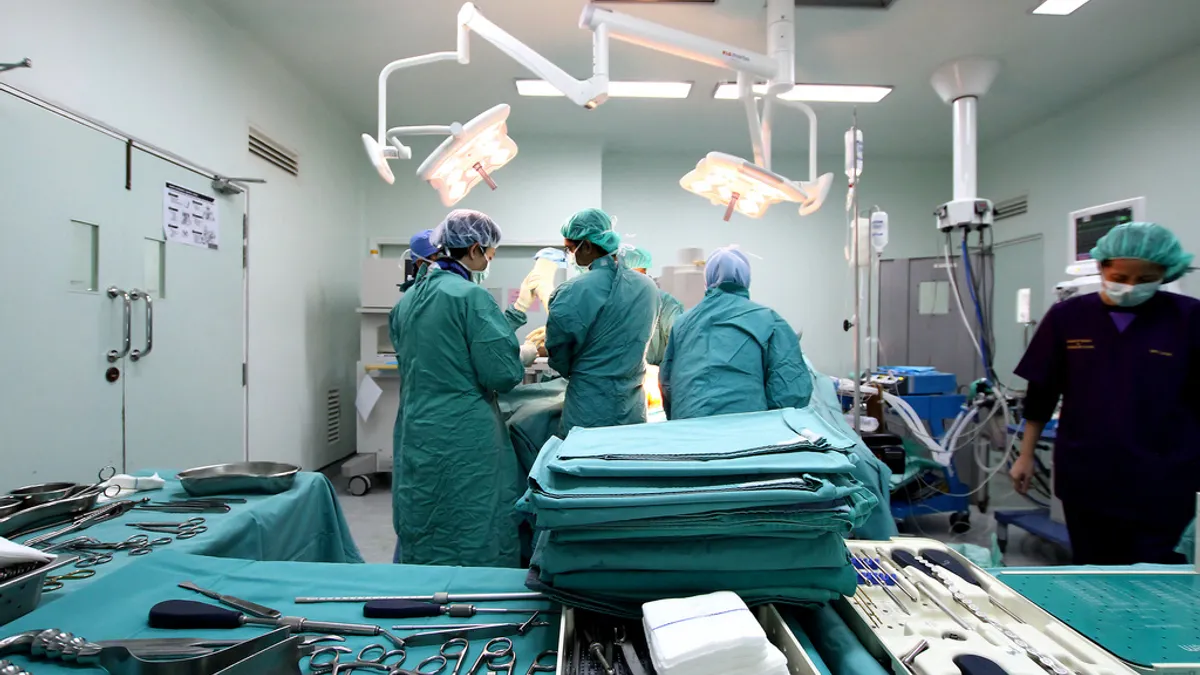Dive Brief:
-
North American cardiovascular societies have crafted joint guidance on the safe reintroduction of invasive procedures and diagnostic tests, as more U.S. states ease restrictions on elective medical care.
-
The harmonized guidance, published Monday in the Journal of the American College of Cardiology, discusses how surgeons should make decisions on restarting invasive cardiovascular care caseloads, including procedures like transcatheter aortic valve replacement (TAVR) and mitral valve repair. The plan details the schedule for restarting procedures involving devices from medtechs including Abbott, Boston Scientific, Edwards and Medtronic.
-
In doing so, the authors hope to ensure patients who will receive the biggest benefit from a procedure are first in line, and aim to avoid a second wave of COVID-19 cases by ensuring adequate testing and personal protective equipment supplies as restrictions are lifted.
Dive Insight:
The deferral of elective cardiovascular procedures looks set to hit many device makers especially hard in the second quarter.
Having seen “the system really screech to a halt” in the last few weeks of March, sending TAVR sales spiraling downward, Edwards Lifesciences is braced for a rocky period. Likewise, mitral valve repair device maker Abbott also took a hit starting in March.
But numerous medtechs have expressed optimism that following second-quarter lows, the third and fourth quarters will show signs of improvement as healthcare systems begin to work through pent-up demand. And cardiologists continue to highlight the fact that deferred care, even if it reduces the spread of COVID-19, results in other adverse outcomes.
"Delays in the treatment of patients with confirmed cardiovascular disease will be detrimental. Similarly, reduced access to diagnostic testing will lead to a high burden of undiagnosed cardiovascular disease that will further delay time to treatment," the framework says. "Although there will be a myriad of competing demands from multiple disciplines, this risk warrants the prioritization of cardiovascular patients as healthcare systems return to normal capacity."
The American College of Cardiology, American Heart Association, Heart Rhythm Society and more than a dozen other North American cardiovascular societies set out a plan for how that pent-up demand can safely and ethically be addressed. In the guidance, the societies shy away from making firm recommendations about specific timing and instead advise hospitals to work with public health officials to determine when to reintroduce procedures.
The societies limit themselves to statements such as “there should be a sustained reduction in the rate of new COVID-19 admissions and deaths in the relevant geographic area for a prespecified time interval.” The guidance also states “regions must have the necessary critical care capacity, PPE, and trained staff available” before restarting elective cardiovascular procedures. If COVID-19 deaths rise after procedures restart, “there must be immediate and transparent cessation of most elective invasive procedures and tests.”
The guidance therefore sets the stage for geographic variation in the lifting of restrictions, in keeping with the U.S. strategy for exiting lockdown, and potentially for a stop-start process as rises in cases of COVID-19 trigger the renewed deferral of elective procedures.
Other sections of the guidance are more definitive on how the reintroduction of elective procedures will play out. The societies envision a three-step process, with more and more procedures taking place as regions exert ever-more control over the coronavirus crisis.
In the first stage, procedures involving TAVR devices, such as those sold by Edwards and Medtronic, would resume, as will surgeries to implant Abbott’s mitral valve repair device MitraClip. However, only patients in a severe state would be eligible for treatment with TAVR and MitraClip during that stage. The societies are advocating for a similar, risk-based approach in other areas, for example by recommending limiting left atrial appendage closure (LAAC), a procedure involving Boston Scientific’s Watchman, to “selective cases.”
The guidance calls for decisions about who gets treated first to be based on “robust ethical analysis.” In practice, that will mean considering factors such as the life years a procedure is likely to save and the risk of exacerbating COVID-19 spread in decisions about who gets treated when.
As regions move into the second stage of the reintroduction process, the need to make decisions about the rationing of care should begin to fade away. In the second stage, the societies foresee the reintroduction of most services. For TAVR, MitraClip and LAAC that will mean some stable cases may still be deferred but most people who need treatment will get it. In the third stage, routine services for most procedures will resume.
The publication of the guidance follows the issuance of advice from the Centers for Medicare and Medicaid Services about the reintroduction of services. There are signs that providers are nearing the point at which they will start to put the advice into action, with management at hospital chain Community Health Systems predicting “every market will be in a position to restore services throughout the month of May.”











